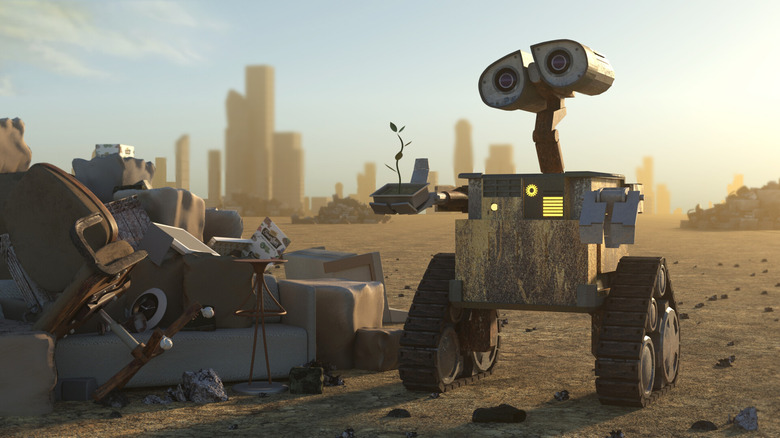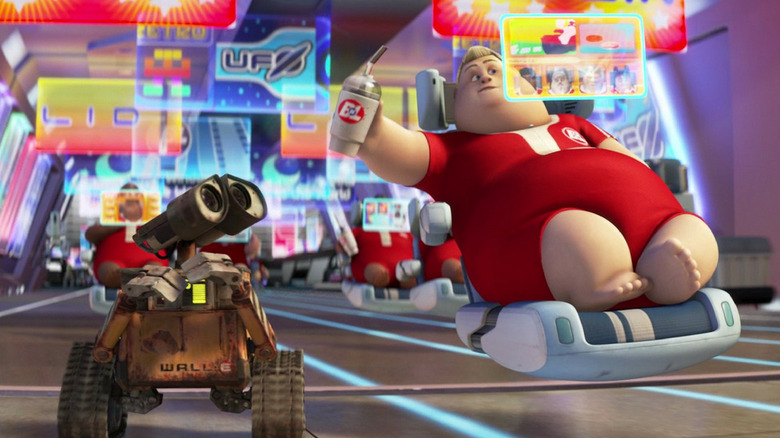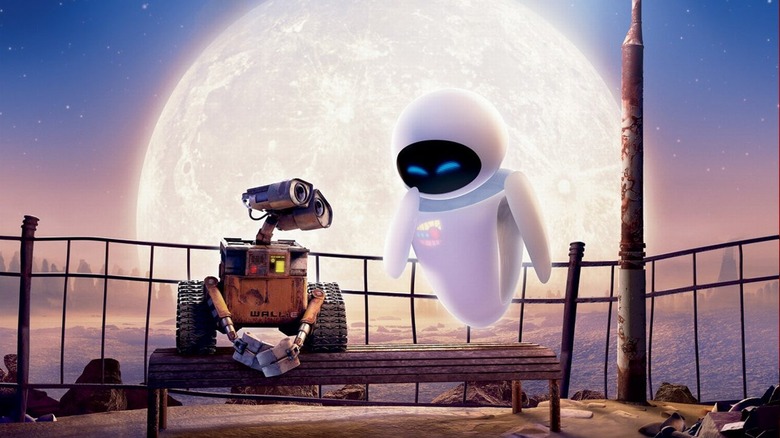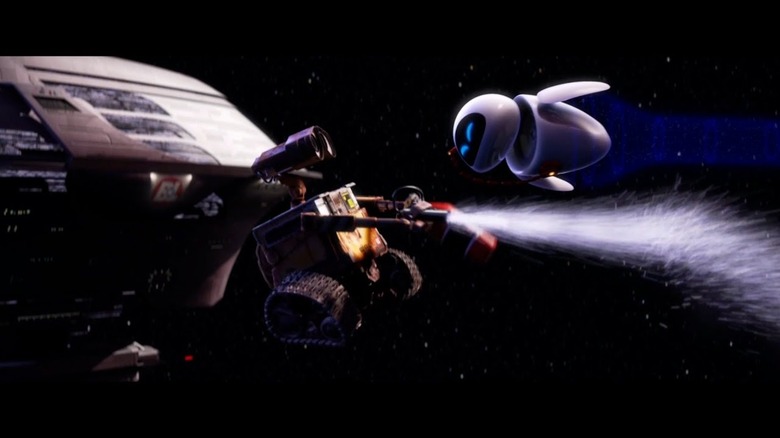
When it comes to Pixar — and indeed most any animated feature — human characters are not par the course. Many of the animation studio's iconic shorts and feature-length films relegate people to periphery roles. From "Toy Story" and "Finding Nemo" to "A Bugs Life" and "Cars," all are brought to life to imbue new magic to the previously mundane. So while robots with feelings might not have been the most revolutionary idea to pop up in 2008 that didn't stop "Wall-E" from melting hearts. Spurned by curiosity and affection for the probe droid EVE, the film's eponymous waste-collecting automaton helps alert the humans who've left an environmentally trashed Earth that plant life has returned.
Despite not being able to communicate in full words many robotic characters in the film lack anything but personality — which is owed to the talents of one man: sound designer and voice actor Ben Burtt. The very same person behind the enthusiastic blips and howling beeps of perhaps one of the most famous droids in cinema, R2-D2. The voices he gives the characters in "Wall-E" are as irreplaceable as the animations of the robots themselves, it's the unique noises of Wall-E or Eve that I imagine hearing first before picturing them. And somehow director and co-writer Andrew Stanton managed to wrangle Burtt into doing far more extensive work than he'd ever done on a "Star Wars." Yet without him, there's a good chance "Wall-E" would've been a much different movie, one absent of the indelible and life-like temperaments he gives every robot he voices.
Getting Wall-E To Be More Like R2D2

Initially, Burtt's work seminal voice-acting as R2-D2 was just a reference point for Stanton's vision of Wall-E. Speaking with The Hollywood Reporter, he admitted to badgering producer Jim Morris about getting the voice as close in spirit to the "Star Wars" droid's own whimsical sounds. "I kept saying for about two years to my producer: 'I need it like R2-D2! I need it like R2-D2,'" Stanton explained until finally, they did just that. But there was one slight wrinkle: according to the "Wall-E" production notes, after finishing work on "Revenge of the Sith," Burtt had sworn off doing anything remotely similar ever again. "No more robots," he reportedly told his wife not long before he was asked to join "Wall-E." Luckily for Stanton and anyone else who loves the film, Burtt quickly changed his mind when he realized how different an experience it would be from making "Star Wars."
"Fortunately, it was such a fresh and exciting idea, and the challenge of the sound in the film really appealed to me. Sound and the robot voices were going to play such an unusual role that I couldn't help but be inspired. So, of course, I signed on to work with Jim and Andrew and do the sound design for the film."
As part of his first animated feature, Burtt would prove to be far more invaluable to the film than Stanton or anyone else could possibly realize. Not only did he provide the voices for Wall-E, M-O, and Auto — he was also responsible for the rest of the film's sound effects. Creating a library of 2,400 files that surpassed in size even his work on "Star Wars." Apart from his prolific work, one of Stanton's other reasons for wanting Burtt was his knack for making the lifeless spectacularly personable.
Two Types Of Robots

There's a reason the machines in "Wall-E" look like the droids seen in the sci-fi universes of "Star Wars" or "Star Trek," and not, say, "Terminator" or "I, Robot." In an interview with Cinema Blend, Stanton was asked about the aesthetic choices he made in designing the robots of "Wall-E." He explained:
"Being a sci-fi geek myself and going to movies all my life, I came to the conclusion that there were really two camps of how robots have been designed. It's either the tin man, which is a human with metal skin, or it's an R2D2. It's a machine that has a function and it's designed based on that and you read a character into it. I was very interested in going with the machine side because to me that was what was fascinating."
It makes sense that Stanton leans more towards robots that aren't humanoid in design given he based Wall-E's sounds off an astromech droid like R2-D2. A machine shouldn't have to look like a human for an audience to care about it. After all, the very idea that personality can be bestowed upon virtually any inanimate thing seems to be the very core motto of Pixar. This also might've been one of the reasons Burtt found the story of "Wall-E" so refreshingly interesting in the first place. Here was a movie in which the robots weren't side characters but the driving forces of the plot, complete with their own complex voices and motivations.
Giving Robots A Personality

He might be a fan favorite but R2D2 obviously played a smaller role in "Star Wars" than Wall-E did in his own film. Which for Burtt, was an opportunity to really see how far he could really push his already legendary skill at giving voice to the typically voiceless. Within the "Wall-E" production notes he goes into detail about the reasons he thought working on the film would be so exciting.
"The challenge of this film was to create character voices that the audience would believe are not human. Yet they could relate to the characters with all the intimacy, affection and identity that they'd attribute to a living human character. The voices couldn't just sound like a machine with no personality or like an actor behind a curtain imitating a robot. It was a weird balance between sounding like it was generated by a machine but still having the warmth and intelligence—I call it soul—that a human being has."
Since the robots are center-stage, Burtt's sounds had to be as distinct to each robot as they are communicative of their various idiosyncrasies. Which explains Stanton's frantic need to just get the man who did it first and subsequently set the bar so impossibly high with his work on R2-D2. Throughout "Wall-E" its expressive robots articulate their love, anger, confusion, and frustration wordlessly but intelligibly. But the complexities don't stop at Burtt's attempts to illustrate them as passionate things.
Manipulating Human Voices Into Synthetic Ones

The process of transforming Burtt's voice and the voices of others into the distorted robotic sounds we hear in the film was no less mind-boggling or sci-fi in its own right. To make their voices he ran recordings through his computer in order to break down the audio files – like light through a prism – into isolated parts. Burtt continued:
"Once you've broken the sound into all its component parts, you can start re-fabricating it back together again. But now you can control the amounts of one thing or another. I can inject a machine-like quality into the sound and do things to it that the human vocal [cords] could never really do. You can hold a certain vowel longer and stretch it. You can change the pitch of something up and down. You can put two sounds close together. In re-fabricating the sound with a particular program I developed, I was able to keep as much of the original performance as I wanted but add a bit of synthetic form to it."
Burtt did something similar for EVE, which was created by tweaking the voice of Elissa Knight until it no longer resembled a human voice. Like Wall-E, it was essential that EVE also had a clearly defined and perceptible personality. Both as the film's co-hero and as Wall-E's love interest. He also got immensely creative, using everything from a hand-cranked inertia starter from a 1930s biplane to a ten-foot radio-controlled jet plane for sounds made by both. Burtt might've sworn off doing any more robot movies but it's clear he was really the only man for the job.
Read this next: The Horror Movies We Can't Wait To See In 2022
The post Pixar Brought In A Star Wars Heavyweight For Some Help On Wall-E appeared first on /Film.
0 Commentaires